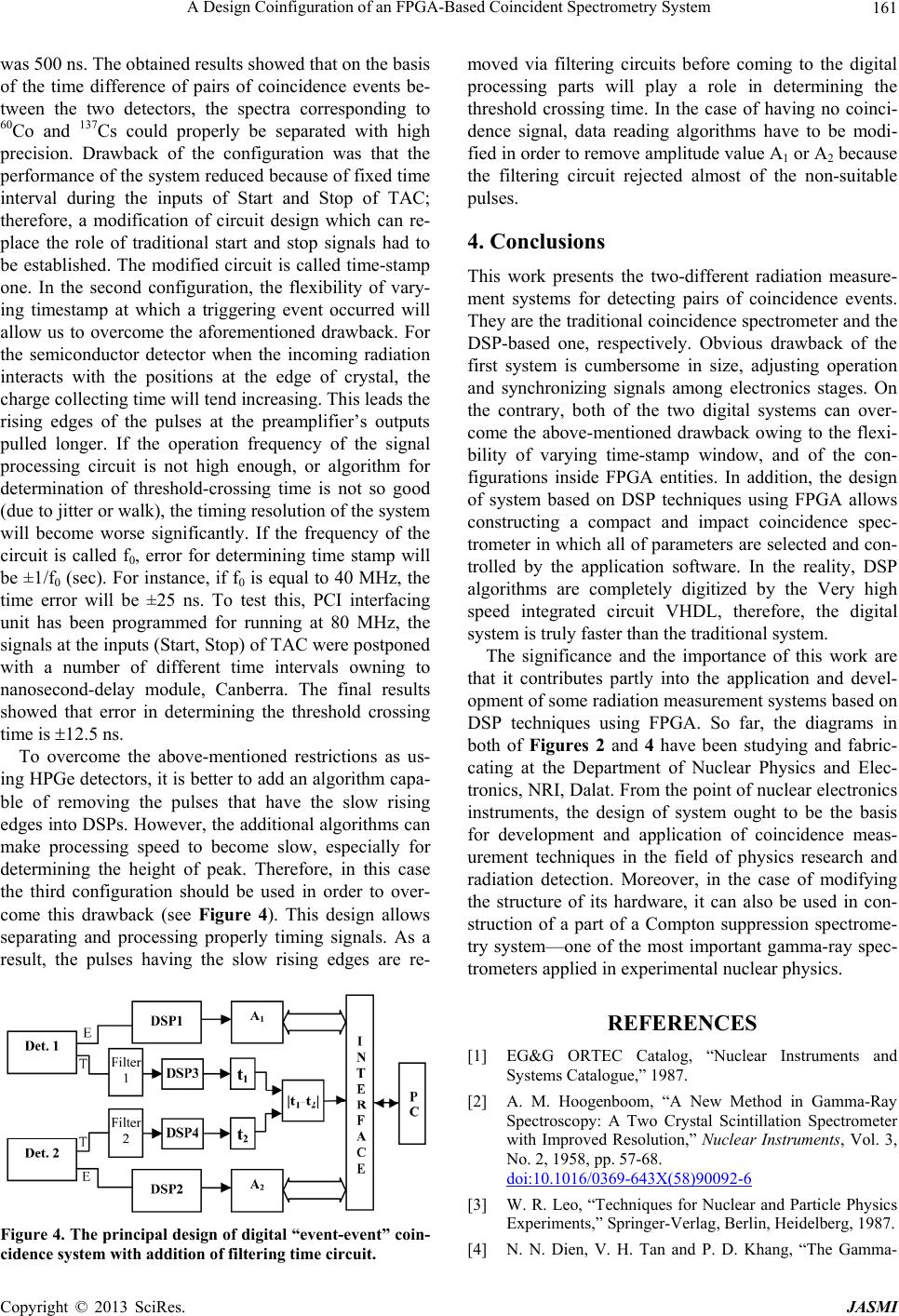
A Design Coinfiguration of an FPGA-Based Coincident Spectrometry System 161
was 500 ns. The obtained results showed that on the basis
of the time difference of pairs of coincidence events be-
tween the two detectors, the spectra corresponding to
60Co and 137Cs could properly be separated with high
precision. Drawback of the configuration was that the
performance of the system reduced because of fixed time
interval during the inputs of Start and Stop of TAC;
therefore, a modification of circuit design which can re-
place the role of traditional start and stop signals had to
be established. The modified circuit is called time-stamp
one. In the second configuration, the flexibility of vary-
ing timestamp at which a triggering event occurred will
allow us to overcome the aforementioned drawback. For
the semiconductor detector when the incoming radiation
interacts with the positions at the edge of crystal, the
charge collecting time will tend increasing. This leads the
rising edges of the pulses at the preamplifier’s outputs
pulled longer. If the operation frequency of the signal
processing circuit is not high enough, or algorithm for
determination of threshold-crossing time is not so good
(due to jitter or walk), the timing resolution of the system
will become worse significantly. If the frequency of the
circuit is called f0, error for determining time stamp will
be ±1/f0 (sec). For instance, if f0 is equal to 40 MHz, the
time error will be ±25 ns. To test this, PCI interfacing
unit has been programmed for running at 80 MHz, the
signals at the inputs (Start, Stop) of TAC were postponed
with a number of different time intervals owning to
nanosecond-delay module, Canberra. The final results
showed that error in determining the threshold crossing
time is 12.5 ns.
To overcome the above-mentioned restrictions as us-
ing HPGe detectors, it is better to add an algorithm capa-
ble of removing the pulses that have the slow rising
edges into DSPs. However, the additional algorithms can
make processing speed to become slow, especially for
determining the height of peak. Therefore, in this case
the third configuration should be used in order to over-
come this drawback (see Figure 4). This design allows
separating and processing properly timing signals. As a
result, the pulses having the slow rising edges are re-
Figure 4. The principal design of digital “event-event” coin-
cidence system with addition of filtering time circuit.
moved via filtering circuits before coming to the digital
processing parts will play a role in determining the
threshold crossing time. In the case of having no coinci-
dence signal, data reading algorithms have to be modi-
fied in order to remove amplitude value A1 or A2 because
the filtering circuit rejected almost of the non-suitable
pulses.
4. Conclusions
This work presents the two-different radiation measure-
ment systems for detecting pairs of coincidence events.
They are the traditional coincidence spectrometer and the
DSP-based one, respectively. Obvious drawback of the
first system is cumbersome in size, adjusting operation
and synchronizing signals among electronics stages. On
the contrary, both of the two digital systems can over-
come the above-mentioned drawback owing to the flexi-
bility of varying time-stamp window, and of the con-
figurations inside FPGA entities. In addition, the design
of system based on DSP techniques using FPGA allows
constructing a compact and impact coincidence spec-
trometer in which all of parameters are selected and con-
trolled by the application software. In the reality, DSP
algorithms are completely digitized by the Very high
speed integrated circuit VHDL, therefore, the digital
system is truly faster than the traditional system.
The significance and the importance of this work are
that it contributes partly into the application and devel-
opment of some radiation measurement systems based on
DSP techniques using FPGA. So far, the diagrams in
both of Figures 2 and 4 have been studying and fabric-
cating at the Department of Nuclear Physics and Elec-
tronics, NRI, Dalat. From the point of nuclear electronics
instruments, the design of system ought to be the basis
for development and application of coincidence meas-
urement techniques in the field of physics research and
radiation detection. Moreover, in the case of modifying
the structure of its hardware, it can also be used in con-
struction of a part of a Compton suppression spectrome-
try system—one of the most important gamma-ray spec-
trometers applied in experimental nuclear physics.
REFERENCES
[1] EG&G ORTEC Catalog, “Nuclear Instruments and
Systems Catalogue,” 1987.
[2] A. M. Hoogenboom, “A New Method in Gamma-Ray
Spectroscopy: A Two Crystal Scintillation Spectrometer
with Improved Resolution,” Nuclear Instruments, Vol. 3,
No. 2, 1958, pp. 57-68.
doi:10.1016/0369-643X(58)90092-6
[3] W. R. Leo, “Techniques for Nuclear and Particle Physics
Experiments,” Springer-Verlag, Berlin, Heidelberg, 1987.
[4] N. N. Dien, V. H. Tan and P. D. Khang, “The Gamma-
Copyright © 2013 SciRes. JASMI